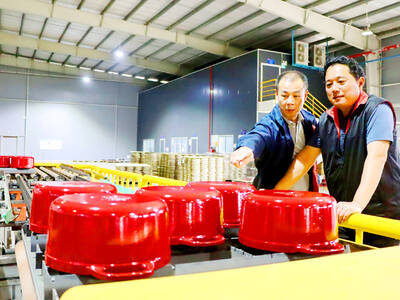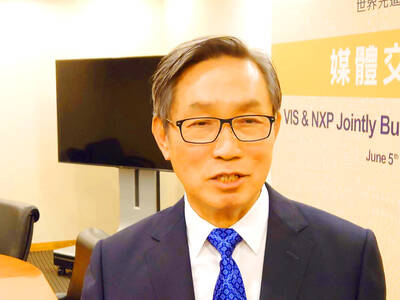Asustek Computer Inc (華碩) on Saturday said it is ready to make a push into the mainstream smartphone market this year with its low-cost ZenFone range, which is gaining traction among consumers worldwide.
Asustek chairman Jonney Shih (施崇棠) said that after the launch of the first-generation ZenFone in January last year, this year will be the year the company plays a bigger role in the worldwide smartphone market.
Earlier this month, Asustek unveiled its new ZenFone Zoom at the annual Consumer Electronics Show in Las Vegas, displaying an Android smartphone with an optical zoom camera.
The firm also introduced the second-generation low-cost ZenFone range, dubbed the ZenFone 2, which is set to go on sale in March at US$199, while the ZenFone Zoom is to be available in the second quarter at US$399.
“The ZenFone gave us a chance to play in the minor league, and now we are ready to challenge the major league,” Shih said at the PC maker’s annual year end banquet, or wei ya (尾牙), for employees on Saturday.
In November last year, Asustek CEO Jerry Shen (沈振來) estimated the company’s smartphone shipments for last year were 8 million units, and forecast shipments of 16 million units for this year.
Shen said the company plans to expand the availability of its ZenFones from 14 markets last year to about 20 markets this year, concentrating more on China and Japan. The firm’s smartphone business is expected to turn profitable this year, comprising about 15 percent of total revenue, he added.
Asustek is scheduled to report its earnings results for last quarter on Feb. 13 when it will outline its business outlook for this year.
Investors are cautious about the firm’s foreign exchange risks in emerging markets, potential smartphone profitability and growth prospects for desktop and motherboard businesses this year.
“While we believe Asustek’s smartphone shipments will continue to grow in 2015, we have concerns over profitability, as competition from Chinese companies like Xiaomi [小米] in emerging markets is growing and there is potential for a cut to Intel’s smartphone CPU subsidy and promotional support,” Barclays Bank wrote in a client note on Thursday last week. “Potential Russia and emerging market demand slowdown from currency weakness is also a concern.”
Asustek on Saturday also hinted that its next smartwatch might come with a battery life of up to seven days, thanks to the adoption of simplified chipset and mobile operating system designs.
“The ZenWatch is defined by us as a companion to a smartphone, and we think it still has a lot of room for improvement,” Shih said. “As a companion device, its central processing unit and operating system should be more simplified than the current version, so that I can use it for up to seven days on one charge, rather than for just two days.”
Asustek’s first smartwatch, dubbed ZenWatch, was launched just before the IFA electronics trade show in Germany in early September last year. The smartwatch has a battery life of up to two days.
At the launch of the first ZenWatch, priced from NT$5,990 (US$192), in Taiwan on Dec. 24 last year, Shen let slip that Asustek was planning a second-generation ZenWatch for the third quarter of this year, and that the upgraded device would offer a new level of independence from smartphones by allowing voice calls without being tethered to a handset.
The company also intends to unveil two other “wristband-like” devices at a lower price, with health management features such as the ability to measure footsteps, heartbeat, pulse and blood sugar, Shen said, without elaborating on a timetable.
Additional reporting by Kevin Chen

TAKING STOCK: A Taiwanese cookware firm in Vietnam urged customers to assess inventory or place orders early so shipments can reach the US while tariffs are paused Taiwanese businesses in Vietnam are exploring alternatives after the White House imposed a 46 percent import duty on Vietnamese goods, following US President Donald Trump’s announcement of “reciprocal” tariffs on the US’ trading partners. Lo Shih-liang (羅世良), chairman of Brico Industry Co (裕茂工業), a Taiwanese company that manufactures cast iron cookware and stove components in Vietnam, said that more than 40 percent of his business was tied to the US market, describing the constant US policy shifts as an emotional roller coaster. “I work during the day and stay up all night watching the news. I’ve been following US news until 3am

Six years ago, LVMH’s billionaire CEO Bernard Arnault and US President Donald Trump cut the blue ribbon on a factory in rural Texas that would make designer handbags for Louis Vuitton, one of the world’s best-known luxury brands. However, since the high-profile opening, the factory has faced a host of problems limiting production, 11 former Louis Vuitton employees said. The site has consistently ranked among the worst-performing for Louis Vuitton globally, “significantly” underperforming other facilities, said three former Louis Vuitton workers and a senior industry source, who cited internal rankings shared with staff. The plant’s problems — which have not

TARIFF CONCERNS: The chipmaker cited global uncertainty from US tariffs and a weakening economic outlook, but said its Singapore expansion remains on track Vanguard International Semiconductor Corp (世界先進), a foundry service provider specializing in producing power management and display driver chips, yesterday withdrew its full-year revenue projection of moderate growth for this year, as escalating US tariff tensions raised uncertainty and concern about a potential economic recession. The Hsinchu-based chipmaker in February said revenues this year would grow mildly from last year based on improving supply chain inventory levels and market demand. At the time, it also anticipated gradual quarter revenue growth. However, the US’ sweeping tariff policy has upended the industry’s supply chains and weakened economic prospects for the world economy, it said. “Now

COLLABORATION: Given Taiwan’s key position in global supply chains, the US firm is discussing strategies with local partners and clients to deal with global uncertainties Advanced Micro Devices Inc (AMD) yesterday said it is meeting with local ecosystem partners, including Taiwan Semiconductor Manufacturing Co (TSMC, 台積電), to discuss strategies, including long-term manufacturing, to navigate uncertainties such as US tariffs, as Taiwan occupies an important position in global supply chains. AMD chief executive officer Lisa Su (蘇姿丰) told reporters that Taiwan is an important part of the chip designer’s ecosystem and she is discussing with partners and customers in Taiwan to forge strong collaborations on different areas during this critical period. AMD has just become the first artificial-intelligence (AI) server chip customer of TSMC to utilize its advanced